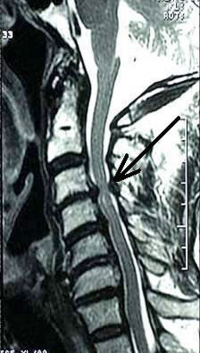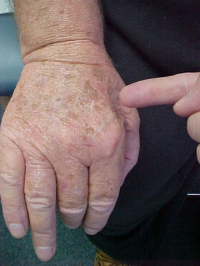Cervical Central Canal Stenosis and Myelopathy Overview
The majority of people living will experience neck pain at some point in their lives. Causes of neck pain can be the result of genetic type degenerative changes and the effects of trauma, sports and occupation, or other cervical spinal diseases. Of these individuals, some will develop cervical central canal stenosis. Symptoms from this condition can lead to pain, weakness and numbness in the cervical spinal canal. This is a condition where cervical canal narrowing puts pressure on the spinal cord or places the spinal cord in jeopardy with a fall or impact. This cervical canal narrowing that essentially leads to spinal cord pinching is a condition that is more frequent in the aging population especially by those who are over 50 and have endured wear and tear on the spine.
Many patients who are suffering from cervical central canal stenosis and myelopathy have experienced trauma in the neck area either through an injury or accident. Sometimes, the cervical stenosis symptoms take years to surface as the degenerative process that causes spinal (cervical) canal narrowing by bone spurs and disc bulging is the hallmark of this disorder. Some individuals have congenital narrowing which means they were born with neck canal narrowing and the symptoms can occur earlier in life.
Biomechanics
It is important to know what happens to a spinal canal with neck motion. Bending the head forward causes the spinal canal to enlarge by as much as 30% and conversely, bending the head backwards causes reduction (or narrowing) of as much as 30%. With spinal stenosis, as the cervical canal narrowing takes place, there is pressure placed on the spinal cord and it begins to dysfunction-a condition called myelopathy. Degenerative myelopathy of the neck causes cervical pain. In the neck, there are occasions where the cord can be acutely pinched with a forceful blow to the front of the head causing the head to bend violently backwards, a condition called central cord syndrome-a type of spinal cord injury. Please see the section on spinal cord injuries to find out more about central cord syndrome.
Are you suffering from symptoms of cervical central canal stenosis?
Would you like to consult with Dr. Corenman about your condition?
You can set up a long distance consultation to discuss your
current X-rays and/or MRIs for a clinical case review.
(Please keep reading below for more information on this condition.)
Cervical Central Canal Stenosis Symptoms
The spinal cord is an extension of the lower part of the brain. It is not just a message delivery system but has some important complex processes to keep muscle coordination and bowel/bladder function normal. When spinal cord pinching and spinal cord compression occurs in a condition called cervical central canal stenosis, the spinal cord dysfunctions and myelopathy results.
Myelopathy has been called the great imposter of causes of neck pain as the symptoms are so unusual that the condition is rarely diagnosed except by a spine specialist. The symptoms start with imbalance with walking. The symptoms can be very subtle in the beginning. Walking in a very dark room (no visual clues) and stumbling can be one of the first signs. Imbalance can extend to the hands. Inability to use the hands for fine motor skills (picking up a dime off a smooth counter, zipping a zipper, difficulty with putting a key into a lock or even a change in handwriting) can be telling. Symptoms can progress to unusual pins and needles sensations and feelings into the arms or legs, electric like zapping sensations down the back or arms with neck motion (L’hermitte’s sign), bowel and bladder problems and neck pain. Weakness can be noted in the legs.
There are specific signs that occur with myelopathy that are apparent on a careful physical examination and can help confirm the presence of this condition. An MRI of the neck (and occasionally of the thoracic spine) is mandatory if myelopathy is suspected.
Cervical Central Canal Stenosis Treatment
Non-Surgical
Degenerative myelopathy of the neck is a condition that is not commonly treated without surgery as it is a continuing injury to the spinal cord and only in rare exceptions is surgery recommended.
Surgical
There are surgical procedures of the spine that can help relieve the pressure on the spinal cord or prevent a future injury to the cord. Surgery for cervical central stenosis is designed to relieve pressure from spinal cord compression and/or spinal cord pinching and if there are already significant symptoms present, the relief of pressure on the cord should prevent future problems but may not be effective in relieving present symptoms. Surgery can include:
- An anterior fusion (ACDF) can decompress the cord and also create stability to segments that are currently unstable and injuring the spinal cord
- A decompressive laminectomy can be performed to create more space in the spinal canal for the nerves that exist there; this is done by removing the vertebral roof (lamina) and making more space for the cord.
- A posterior laminoplasty can also be performed and is done by lifting the lamina to one side. This expansion helps to open the spinal canal and helps to retain more spinal stability.
For more information on cervical central canal stenosis and degenerative myelopathy of the neck, or for additional resources on the causes of neck pain and other cervical spinal diseases, please contact Dr. Donald Corenman, neck doctor and spine specialist in the Vail, Aspen, Denver and Grand Junction, Colorado area.
Related Content
- Cervical Degenerative Kyphosis
- Cervical Degenerative Spondylolisthesis
- Chronic Radiculopathy
- Cervical Degenerative Disc Disease
- Cervical Spine Instability
- Cervical Spine Fractures and Dislocations
- Failed Artificial Cervical Disc Replacement
- How to Describe Your History and Symptoms of Neck, Shoulder and Arm Pain
- Best Questions to Ask When Interviewing a Spine Surgeon or Neurosurgeon
- When to Have Neck Surgery


